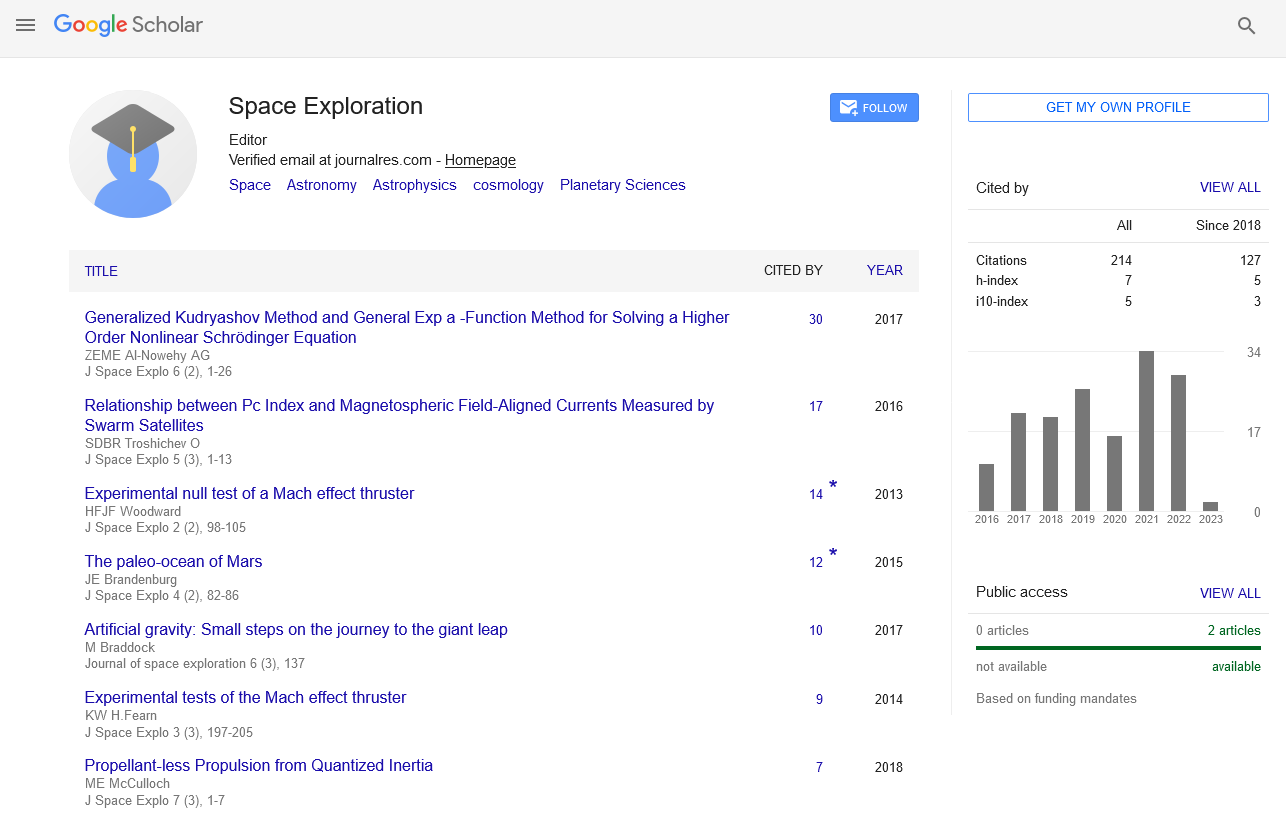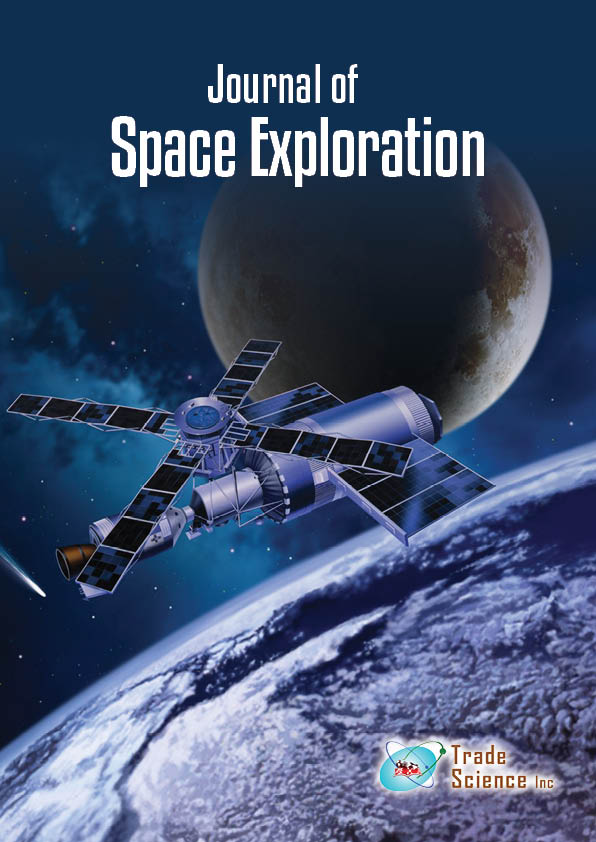Perspective
, Volume: 13( 12)The Role of Robotics in Space Exploration: Current Applications and Future Prospects
Received date: Dec-8-2024, Manuscript No tsse-25-159413; Editor assigned: Dec-10-2024, Pre-QC No. tsse-25-159413(PQ); Reviewed: Dec - 12-2024, QC No tsse-25-159413(Q); Revised: Dec-14-2024, Manuscript No. tsse-25-159413(R); Published: Dec-30-2024, DOI.10.37532/2320- 6756.2024.13(12).381
Citation: Bennett A. The Role of Robotics in Space Exploration: Current Applications and Future Prospects. J Space Explor.2024;13(12).381
Abstract
Robotics has become an integral component of space exploration, significantly enhancing the ability to explore and understand the universe. From autonomous rovers on Mars to satellite servicing and asteroid mining, robots are transforming how we study space. They not only assist astronauts but also take on missions that are too dangerous, distant, or impossible for humans to conduct. This commentary explores the current applications of robotics in space exploration, highlighting their pivotal role in enhancing scientific discovery and human presence in space. It also looks ahead at the future prospects of robotics in deep space missions and human colonization efforts.Introduction
Space exploration has long been the domain of human curiosity and ambition, with technological advances allowing us to reach farther into the cosmos. In recent decades, robotics has become a cornerstone of these advances, enabling space missions to perform complex tasks beyond the capabilities of human astronauts. Space robots—ranging from rovers and landers to satellites and robotic arms—are designed to gather data, repair equipment, and even build infrastructure in outer space.
The significance of robotics in space exploration cannot be overstated. These machines are capable of withstanding the harsh conditions of space, such as extreme temperatures, radiation, and microgravity. Robots also reduce the risks to human life, conduct operations in environments that are too far or too dangerous for human presence, and provide valuable data that contributes to a greater understanding of outer space. As the exploration of the Moon, Mars, and beyond continues to evolve, robotics will play an ever-expanding role in shaping the future of space exploration.
Current applications of robotics in space exploration
One of the most well-known applications of robotics in space exploration is the use of rovers on Mars. NASA’s Perseverance rover, for example, has been actively exploring the Martian surface, conducting geological surveys, collecting samples, and testing new technologies. Rovers provide an invaluable opportunity to explore distant planets without the need for human intervention. These robotic systems operate autonomously, navigating challenging terrains and transmitting data back to Earth.
Satellites equipped with robotic arms and tools are also used for a variety of tasks, such as servicing other satellites, assembling space stations, and repairing malfunctioning equipment. The Canadian Space Agency’s Remote Manipulator System (Canadarm), used aboard the International Space Station (ISS), is an exemplary application of robotic technology that assists astronauts in spacewalks and maintains the station’s functionality.
Future prospects of robotics in space exploration
The potential for robotics to advance space exploration in the coming years is vast. As we aim for more ambitious missions—such as sending humans to Mars, building permanent lunar bases, or exploring outer planets—robotics will be indispensable for conducting tasks that would be either too dangerous or too resource-intensive for astronauts. For instance, robots may be used to build infrastructure on the Moon or Mars before human astronauts arrive, laying the groundwork for sustainable human habitation in space. Additionally, advancements in Artificial Intelligence (AI) and machine learning will further empower robots to operate autonomously in deep space environments. These robots could navigate and make decisions without constant human input, ensuring that they can function even in remote locations where communication delays are a challenge.
Conclusion
The search for extraterrestrial life continues to be one of the most captivating and important scientific pursuits. With advancements in astrobiology and planetary exploration, humanity is on the brink of making groundbreaking discoveries that could forever change our understanding of life in the universe. Mars exploration, the study of icy moons like Europa and Enceladus, and the detection of exoplanets in habitable zones are all pivotal steps toward this goal. However, the challenges are substantial, and the vastness of space, combined with technological limitations, means that the search will take time. Nevertheless, the growing synergy between astrobiology, space missions, and technological innovation holds promise for revealing the answer to one of humanity's most enduring questions: Are we alone in the universe? In the past, theories about extraterrestrial life were speculative, and the tools needed to search for life beyond Earth were limited. Today, through the combined efforts of space agencies and the application of sophisticated technologies, we have the capability to detect planets in the habitable zone of distant stars, analyze the atmospheres of exoplanets, and explore the surface of planets and moons within our solar system. Robotics is transforming space exploration by enabling tasks that were once considered impossible or too dangerous for humans. From Mars rovers and satellite maintenance to asteroid exploration and infrastructure development on other celestial bodies, robots are enhancing our ability to explore space and laying the foundation for future missions. As technology advances, robotics will continue to evolve, incorporating more sophisticated AI, machine learning, and collaborative systems to carry out increasingly complex tasks autonomously. Looking ahead, robotics will be essential for human missions to the Moon, Mars, and beyond, supporting astronauts and enabling exploration of deeper space regions. As we push further into the cosmos, the synergy between humans and robots will be key to achieving the long-term goals of space exploration, from resource utilization to the establishment of sustainable colonies in space. The future of space exploration is inevitably intertwined with the continued development and application of robotics, providing a glimpse into the vast possibilities of exploring and inhabiting other worlds.

